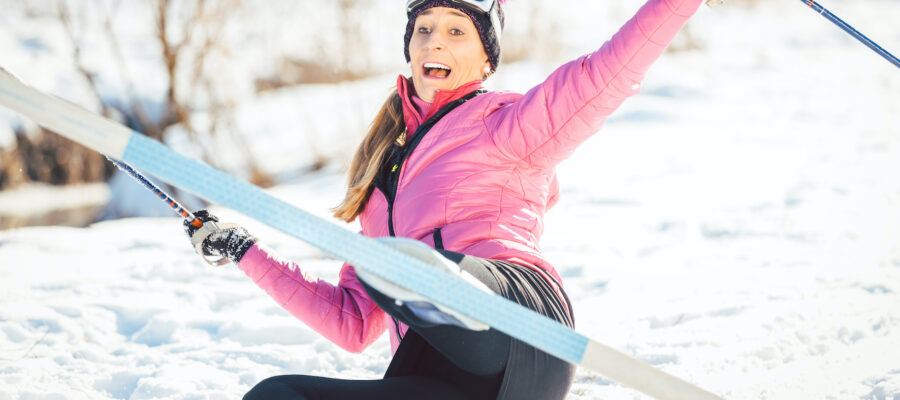Preparing your body for a cross-country skiing adventure begins with a thorough warm-up. Warming up is essential to increase blood flow to your muscles, improve joint mobility, and reduce the risk of injury.
Here’s a comprehensive warm-up routine to help you get ready for your skiing expedition:
1. Aerobic Warm-Up
Start with five to ten minutes of light aerobic exercise to gradually raise your heart rate and warm up your muscles. You can perform activities like brisk walking, jogging in place, or easy cycling if available.
2. Dynamic Stretching
Dynamic stretching involves controlled movements that take your muscles through their full range of motion. These stretches help improve flexibility and activate the muscles you’ll be using during skiing. Perform each of these dynamic stretches for about 20 seconds on each side:
- Leg Swings: Hold onto a support (like a tree or a fence) for balance. Swing one leg forward and backward, gradually increasing the range of motion.
- Arm Circles: Stand with your feet shoulder-width apart. Extend your arms straight out to the sides, and make small forward and backward circles.
- Hip Circles: Stand with your hands on your hips. Rotate your hips in a circular motion, both clockwise and counterclockwise.
- Ankle Circles: While standing, lift one foot slightly off the ground. Rotate your ankle in circles, first clockwise, then counterclockwise.
- Torso Twists: Stand with your feet shoulder-width apart. Twist your upper body gently from side to side, keeping your hips facing forward.
3. Muscle Activation Exercises
Perform a few exercises that specifically target the muscles used in skiing:
- Bodyweight Squats: Stand with your feet shoulder-width apart and perform a few bodyweight squats to activate your quadriceps and glutes. Keep your back straight, and lower your hips as if you’re sitting back into a chair.
- Lunges: Step forward into a lunge position with one leg, then return to the starting position and switch legs. Lunges activate the quadriceps and hip flexors.
- Leg Swings: Stand on one leg and swing the other leg forward and backward. This exercise activates the hip flexors and quadriceps.
4. Static Stretching
After your dynamic warm-up and muscle activation exercises, it’s time for static stretching. Hold each stretch for about 20-30 seconds. Focus on the major muscle groups used in skiing:
- Quad Stretch: Stand on one leg and pull your opposite heel towards your buttocks. Hold onto a support for balance.
- Hamstring Stretch: Sit on the ground with one leg extended and the other bent so that the sole of your foot touches the inner thigh of your extended leg. Reach for your toes.
- Calf Stretch: Stand facing a wall, place your hands on the wall, and step one foot back while keeping it straight. Bend your front knee and lean into the wall to stretch the calf of your back leg.
- Hip Flexor Stretch: Kneel on one knee, with the other foot in front and the knee bent at a 90-degree angle. Gently push your hips forward to stretch the hip flexor of the kneeling leg.
- Upper Body Stretch: Interlace your fingers and reach your arms overhead, stretching your upper body. Lean to one side and then the other.
5. Ski-Specific Movements
Finish your warm-up with ski-specific movements to simulate the skiing motion. These include mimicking the diagonal stride and skate skiing movements for a few minutes to prepare your body for the skiing technique.
Summary
A well-structured warm-up routine prepares your body physically and mentally, reducing the risk of injury and enhancing your skiing experience. Here’s a summary of the different exercises and their benefits:
Aerobic Warm-Up:
- Benefits: Raises heart rate and increases blood flow to muscles, preparing your cardiovascular system for exercise.
Dynamic Stretching:
- Benefits: Enhances joint mobility, improves flexibility, and activates muscles crucial for skiing movements.
Muscle Activation Exercises:
- Benefits: Specifically targets muscles used in skiing, improving strength and stability for the activity.
Static Stretching:
- Benefits: Lengthens major muscle groups, reduces the risk of muscle strains, and improves overall flexibility.
Ski-Specific Movements:
- Benefits: Simulates the skiing motion, mentally preparing you for the technique and ensuring a smooth transition onto the trails.
Remember that the warm-up routine should be adapted to your fitness level and the specific demands of your skiing adventure. It’s essential to prioritize safety and adequately prepare your body before hitting the trails, ensuring an enjoyable and injury-free experience.
However, by incorporating these exercises into your pre-skiing routine, you’ll set the stage for an enjoyable and injury-free experience, allowing you to make the most of your time on the cross-country ski trails.

